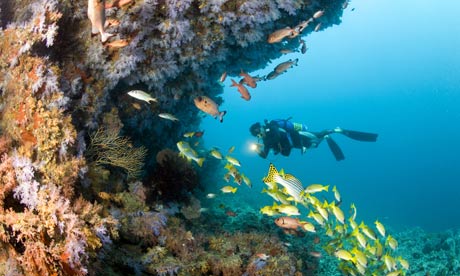TOP STORIES Dolphin Diseases Linked to Human Ailments and Ocean Health
Dolphin Diseases Linked to Human Ailments and Ocean Health
Diseases found in dolphins are similar to human diseases and can provide clues to how human health might be affected by exposure to contaminated coastal water or seafood, said a panel of government, academic and nonprofit scientists speaking today at the annual meeting of the American Association for the Advancement of Science, AAAS.
"Dolphins and humans are both mammals, and their diet includes much of the same seafood that we consume. Unlike us, however, they are exposed to potential ocean health threats such as toxic algae or poor water quality 24 hours a day," said Carolyn Sotka of the NOAA Oceans and Human Health Initiative and lead organizer of the session.
19 Feb 2010
Photo credit: Todd Speakman courtesy NOAA
>>>FULL ARTICLE
Related News
>>>Toxin Triggers Epilepsy In Sea Lions And Humans
Wild bird telemetry project helps FAO to better understand disease ecology of emerging diseases and the role of migratory birds in transmission dynamics
The concept behind wild bird radio telemetry is straightforward: attaching a radio transmitter to a wild bird and track the emitted signals to determine its movements.
This monitoring technique determines bird movements over areas ranging in size from the restricted breeding sites of resident bird species to the pathways of international migratory species.
Telemetry has important applications in the investigation of infectious diseases carried by migratory species, including the virus ecology of H5N1 avian influenza virus and other diseases.
 Animals linked to human Chlamydia pneumoniae
Animals linked to human Chlamydia pneumoniaeAnimals have been found to have infected humans sometime in the past with the common respiratory disease Chlamydia pneumoniae, according to Queensland University of Technology infectious disease expert Professor Peter Timms.
Unlike the sexually-transmitted form of Chlamydia, Chlamydia pneumoniae is a major bacterial germ that causes widespread respiratory disease in humans.
The discovery was made by an international team of scientists from QUT's Institute of Health and Biomedical Innovation and the Institute for Genome Sciences (IGS) at the University of Maryland School of Medicine, who used koalas to prove the link between Chlamydia pneumoniae in animals and humans.
Feb 2010
Photo credit: Erika Fish, Queensland University of Technology
>>>FULL ARTICLE
Cited Journal Article
>>>Evidence that Human Chlamydia pneumoniae Was Zoonotically Acquired. Journal of Bacteriology. 2009 Dec; 191(23): 7225-7233.
 Reported Wildlife Mortality Events to the USGS National Wildlife Health Center Updated
Reported Wildlife Mortality Events to the USGS National Wildlife Health Center UpdatedUSGS and a network of partners across the country work on documenting wildlife mortality events in order to provide timely and accurate information on locations, species and causes of death. This information was updated on February 19, 2010 on the USGS National Wildlife Health Center web page, New and Ongoing Wildlife Mortality Events Nationwide. Quarterly Mortality Reports are also available from this page. These reports go back to 1995.
 Acidified landscape around ocean vents foretells grim future for coral reefs
Acidified landscape around ocean vents foretells grim future for coral reefsHuge vents covering the sea-floor – among the strangest and most spectacular sights in nature – pour carbon dioxide and other gases into the deep waters of the oceans.
Last week, as researchers reported that they had now discovered more than 50,000 underwater volcanic springs, they also revealed a new use for them – as laboratories for measuring the impact of ocean acidification on marine life.
The seas are slowly being made more acidic by the increasing amounts of carbon dioxide from factories and cars being pumped into the atmosphere and then dissolved in the sea.
21 Feb 2010
Photo credit: Michele Westmorland/Getty Images
>>>FULL ARTICLE
Related News
>>>Will coral reefs disappear?
OTHER WILDLIFE HEALTH RELATED NEWS
- US Gov’t Draws Up Plan To Rescue Great Lakes
- Pembrokeshire badger cull decision 'perverse'
- Kansas State University receives $12M for zoonotic and animal disease research
- Calling all New Jersey bat lovers
- Finches Seek Out Sick Dining Companions
 Endangered Species
Endangered SpeciesPhoto credit: Alamy
- On the brink of extinction – 25 of our closest relatives
- Monkeys, butterflies, turtles… how the pet trade's greed is emptying south-east Asia's forests
- Great white sharks 'more endangered than tigers'
It Ain't All Bad News
WILDLIFE HEALTH RELATED PUBLICATIONS
Browse complete Digest publication library here.
 Oiling of live gulls as a tool to monitor acute oil spill effects on seabirds
Oiling of live gulls as a tool to monitor acute oil spill effects on seabirdsIbis. 2010; [Epub ahead of print]
I Munilla and A Velando
Mortality Rates Differ Among Amphibian Populations Exposed to Three Strains of a Lethal Ranavirus
Ecohealth. 2010 Feb 9. [Epub ahead of print]
DM Schock et al.
Isolation of highly pathogenic avian influenza H5N1 virus from Saker falcons (Falco cherrug) in the Middle East
Adv Virol. 2009 Jan 1;2009:1.
H Marjuki et al.
Genetic analysis of avian influenza virus from migratory waterfowl in Mexico
Archives of Virology. 2010 Jan; 155(1): 97-101
M Montalvo-Corral1 and J Hernández
Birth size and postnatal growth in cave- and bridge-roosting Brazilian free-tailed bats
Journal of Zoology. 2010; 280(1): Pages 8 - 16
LC Allen et al.
Journal of Wildlife Management - February 2010
Volume 74, Issue 2
The Wildlifer - January 2010
Issue 358




